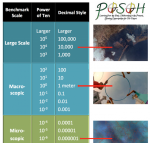POSOH Cosmic Voyage Systems and Scale Poster
This is a printable poster resource developed by a collaboration of educators in the POSOH Project for teaching about systems and scale. This poster correlates with an excerpt from the video Cosmic Voyage about systems and scale, narrated by Morgan Freeman. A debrief discussion of that video excerpt in the context of "What is Air?" is supported by a PowerPoint. Then, those concepts are applied(also supported by a PowerPoint) to the question: "What are plants at the molecular and atomic scale?"These additional resources are available free online (Cosmic Voyage excerpt, editable PowerPoints) and the lessons in which they were used are well described in the downloadable unit (which is a great unit about matter & energy transformations in the context of bioenergy): http://posohproject.org/grade-9-unit
- NGSS.5.LS2.1 Develop a model to describe the movement of matter among plants, animals, decomposers, and the environment. [Clarifcation Statement: Emphasis is on the idea that matter that is not food (air, water, decomposed materials in soil) is changed by plants into matter that is food. Examples of systems could include organisms, ecosystems, and the Earth.] [Assessment Boundary: Assessment does not include molecular explanations.]
- NGSS.HS.LS1.2 Develop and use a model to illustrate the hierarchical organization of interacting systems that provide specific functions within multicellular organisms. [Clarification Statement: Emphasis is on functions at the organism system level such as nutrient uptake, water delivery, and organism movement in response to neural stimuli. An example of an interacting system could be an artery depending on the proper function of elastic tissue and smooth muscle to regulate and deliver the proper amount of blood within the circulatory system.] [Assessment Boundary: Assessment does not include interactions and functions at the molecular or chemical reaction level.]
- NGSS.MS.LS1.3 Use argument supported by evidence for how the body is a system of interacting subsystems composed of groups of cells. [Clarification Statement: Emphasis is on the conceptual understanding that cells form tissues and tissues form organs specialized for particular body functions. Examples could include the interaction of subsystems within a system and the normal functioning of those systems.] [Assessment Boundary: Assessment does not include the mechanism of one body system independent of others. Assessment is limited to the circulatory, excretory, digestive, respiratory, muscular, and nervous systems.]

Comments